
Well, here it is, the University of Alberta Botanic Garden’s new megafolly — a monument to No Swimming Or Wading. Signs are everywhere.
The Aga Khan Garden is named in honour of the globe-trotting super-rich spiritual leader, philanthropist, and racehorse collector, “K” to his friends, whose $25 million gift paid for the stones and the earth-movers and cranes. In October, 2018, he attended the inauguration, a “dream come true,” with a train of dignitaries — politicians, diverse local eminences. “Now we have one of the most elegant and beautiful gardens in Canada, and I would suggest maybe the world,” Premier Rachel Notley told the dignitariat. She knows she’ll be quoted, and inciting the desires of prospective tourists is her job. But this was not the Alhambra. Was it even Little Alhambra on the Prairie?

Contemplate. Twenty massive stone pillars supporting nothing.
Give it five or so years, in fairness. Let plantings fill the beds and grow up to hide the exposed concrete, let shrubs and groundcovers subdue the chip mulch. After the surrounding orchard has reached mature height, the Aga Khan will still preside over the other gardens, but maybe its dominance won’t be so stark and jarring. Still, it’s hard to imagine how it won’t permanently change the character of the whole area. With its channelled, flow-controlled water courses and its smooth-cut and precise-angled stonework, paved walkways and straight-edged lawns, it is a formal urban garden dropped in among country gardens. Would it have fit better somewhere on the University of Alberta campus, or in downtown Edmonton?

Among the Aga Khan Garden’s many ingenious water features, the modern public toilets installed below the deck will be a most welcome addition to the UABG.
The Aga Khan Garden will demand levels of care and maintenance not bestowed on its neighbours — apart from the Kurimoto Garden, which is in a separate and secluded space. Neglect and dereliction commonly seen in the Primula Dell and the Patrick Seymour Alpine Garden — where long-established plants, that in any other botanic garden would be treated as treasures, are allowed to die in a hot, dry season, become inundated by ants, or suffocated in weeds — will not be a feature of the Aga Khan Garden, we can be fairly confident. And could this be the AKG’s saving grace? If the crowds do come, and pay the increased admission fees, could there be money to pay for proper maintenance, and even improvements, in the other gardens?

The exercise yard at a minimum security prison? No, an ornamental gate on one side of the Aga Khan Garden.
Through the woods behind the upper deck’s twenty bleakly bare and weirdly unsupportive pillars lies the Kurimoto Japanese Garden, another space designed for meditation and contemplation. Can a garden visitor be invited to indulge in too much contemplation? I guess not. But is there a risk of the U of A Botanic Garden becoming a botanic garden in name only as it transforms into a Global Centre for Contemplative Experiences (Non-Swimming, Non-Wading) and Wedding Photo Inspirations?
(Come on, K, is there a more blissfully contemplative experience than massaging one’s bare feet in a bed of sharpish granite and shell sand while wading in ankle-deep water? K, you own a private Bahamanian island, you know what I’m talking about.)

This little frog obeys the No Swimming Or Wading signs.

This little frog did not.
As long as they don’t turn the alpine gardens into the Zuckerberg Self-Surveillance and Miniature Golf Paradise, I will continue to visit. (Now I’ve put the idea out there, I have a bad feeling.)
Before we get to the alpines, there is more new architecture and design to look at, quickly, in the new parking lot.
Here, the juxtaposition of an attractive cement wall and a couple of Dollarama-green plastic-clad bollards anticipates the challenging aesthetic clashes to be found in the Aga Khan Garden, where ornate metalwork meets chip mulch.

Has this parking space been left vacant, shunned, because it looks too small? It is actually full-size. The one opposite looks the proper size but is actually extra wide.

The UABG’s new parking lot was paid for by the people of Alberta. However, it has not been named The People of Alberta Parking Lot.
The content of this blog post would be very different had more of my pictures been clear enough to share. I don’t know what happened, but I took a lot of blurry pictures (see above) with a camera that is usually reliable. I am not a photographer but a camera-user. Anyway, on to the plants.
We’ll start in the Patrick Seymour Alpine Garden with this fine, flourishing example of Campanula rotundifolia, the harebell, a wildflower here and in many parts of the world. A botanic garden serves a useful purpose when it demonstrates for local gardeners how well native plans can work as garden ornamentals. Looking at this, you might wonder, where is the rotund foliage? The basal leaves are round or heart-shaped, and visible in spring before the flower stems arise.
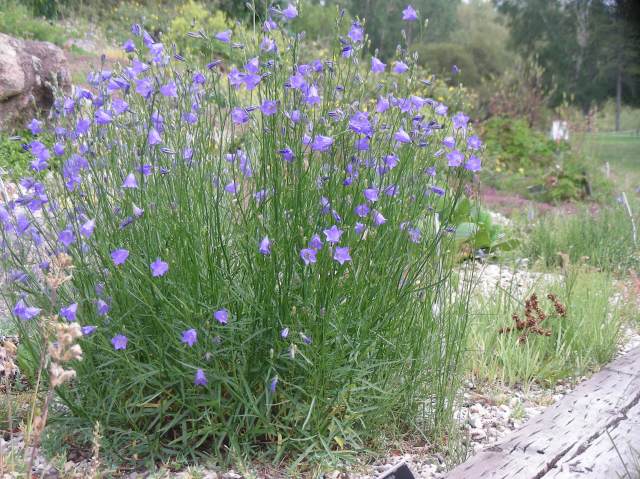
Growing among the gravel, apparently self-sown, are many viola, dianthus, and veronica. This cyclamen-leaved violet, or Korean violet (Viola grypoceras, the internet informs me), is either recently planted or hardier than the seedlings I’ve raised. I’m going to have to try again.
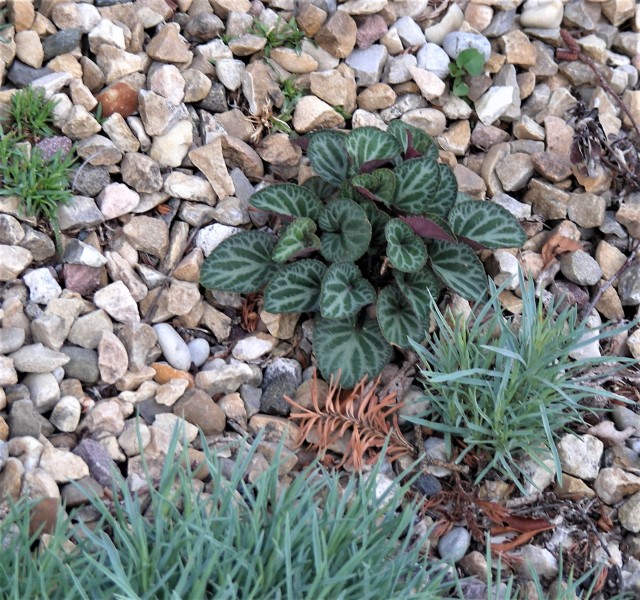
I have this Dianthus, grown from seed acquired from this very garden, several years ago when the fundraising group, Friends of the Garden, used to sell seeds. I didn’t retain the name. Is it D. carthusianorum? It’s a good self-sower at the UABG. I have just one, and this photo reminds to start some of the seed I collected from it last year.
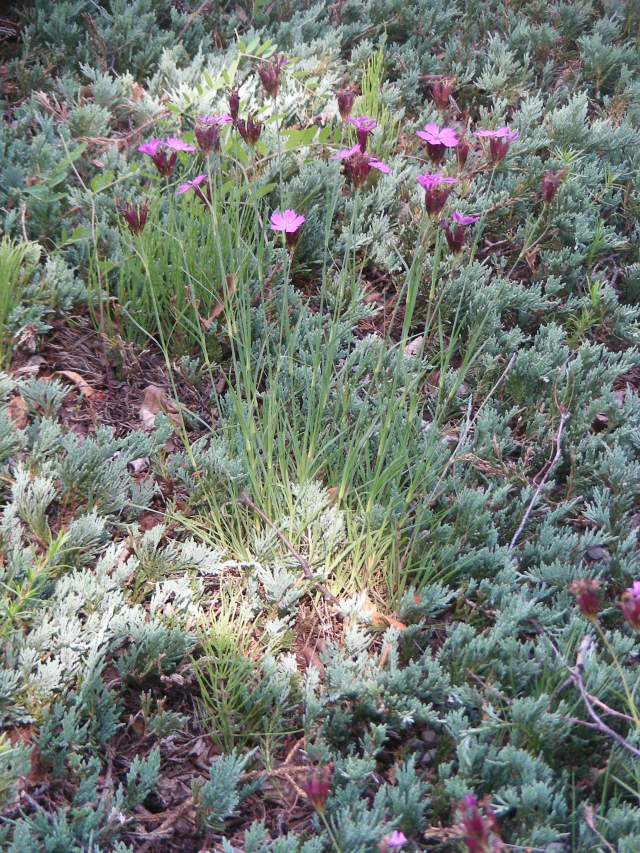
I would grow this. Is the name correct? Onosma taurica. A quick web-search says it is. Another way a botanic garden can be useful to local gardeners — if the names on the ID stakes are correct, which is not something you can count on at the UABG.

I would grow this, too. Veronica allionii. I’ll be looking for seed.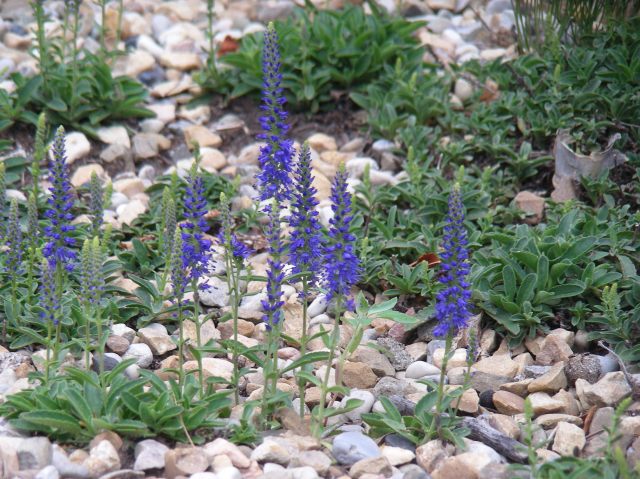
This little Primula marginata is in a happy place. P marginata is an early spring bloomer. Some years, the flowers may be finished before the garden gates open in May.
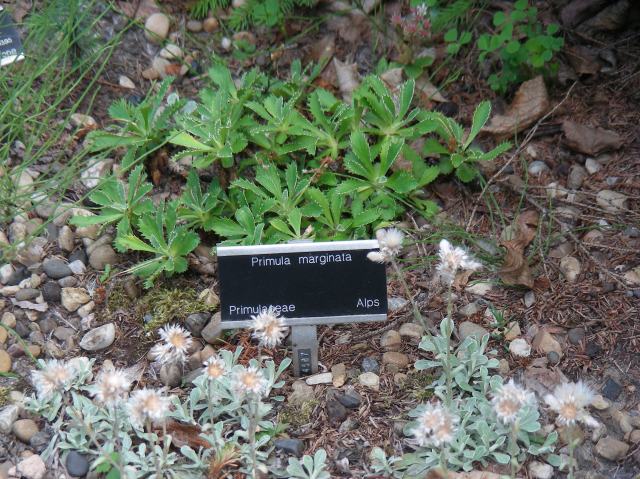
This Primula marginata has been overwhelmed by a rampant Persicaria. Rescued, it could be replanted in a crevice on a north-facing slope, in an alpine trough, and/or in the rebuilt tufa bed. Speaking of which, there were signs of activity (clearing, site preparation) on the under-planted west side of the alpine garden. Could this be the new location for the tufa bed? Or will it be restored to its former location, in the lawn beside the gift shop? Anticipation for the return of the tufa bed now rivals, and may even exceed, that which preceded the opening of the Aga Khan Garden.
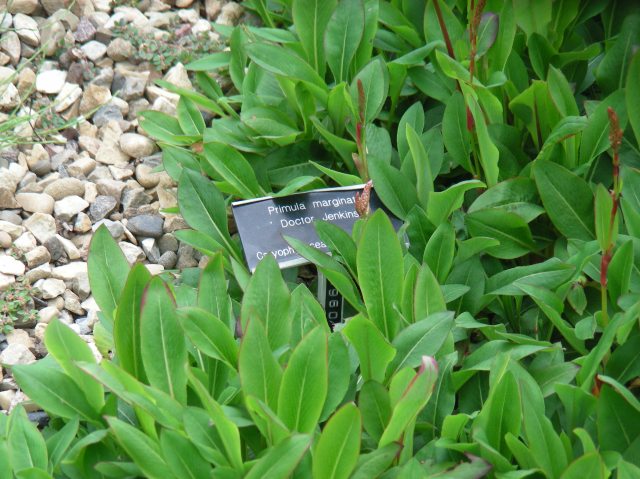
The stacked boulder slabs in the north slope of the alpine garden provide niches where a gardener can tuck little plants. A spot like this would make a good (sheltered and fairly shady) habitat for Haberlea rhodopensis or Primula marginata. The Hens and Chicks and Draba residing there now could probably go in a more exposed, sunnier spot.

I started making this post many months ago. These photos are from 2018. In 2019, we did not visit the UABG. I’m sure we’ll go next year — looking forward, as always, to changes and improvements. The return of the tufa bed, restoration and expansion of the Primula collection (with accurate signage) — too much to ask? (K , buddy, they might listen to you. If you have read this far, maybe you care. Another, say, $25,000; what would that be? A few coins in a wishing well.)
Final pictures. Highlights: that very happy pondside Persicaria; more black-budded Dianthus; Martagons rebounding after the brutal summer of 2017; Astilboides tabularis in the Primula Dell.
Primulas, and a Gentiana acaulis in the Primula Dell















The Dianthus carthusianorum is a great plant. It bloomed all summer long here. The Veronica allionii is also nice, here it spreads into a thick ground cover relatively quickly.